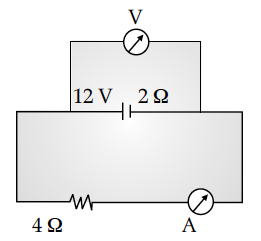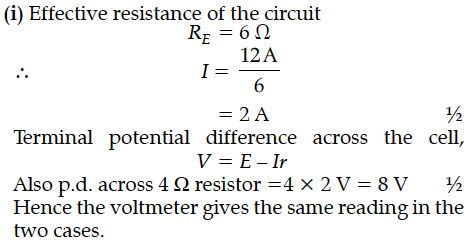A battery of emf 12 V and internal resistance 2 Ω is connected to a 4 Ω resistor as shown in the figure.

(i) Show that a voltmeter when placed across the cell and across the resistor, in turn, gives the same reading.
(ii) To record the voltage and the current in the circuit, why is voltmeter placed in parallel and ammeter in series in the circuit ?

(i) Show that a voltmeter when placed across the cell and across the resistor, in turn, gives the same reading.
(ii) To record the voltage and the current in the circuit, why is voltmeter placed in parallel and ammeter in series in the circuit ?

(ii) It is observed that as voltmeter carries high resistance, it does not change current, Hence, voltmeter is connected in parallel where potential difference to be measured. Further, as ammeter has low value of resistance which assures that all current flows through the circuit, so it is connected in series.
A battery of emf 10 V and internal resistance 3 ohm is connected to a resistor. If the current in the circuit is 0.5 A, find :
(i) the resistance of the resistor;
(ii) the terminal voltage of the battery.
A battery of emf E and internal resistance, r, when connected with an external resistance of 12Ω produces a current of 0.5 A. When connected across a resistance of 25Ω, it produces a current of 0.25 A. Determine
(i) the emf and (ii) the internal resistance of the cell.
A cell of emf 4 V and internal resistance 1 W is connected to a d.c. source of 10 V through a resistor of 5 W. Calculate the terminal voltage across the cell during charging.
A cell of emf ‘E’ and internal resistance ‘r’ is connected across a variable load resistor R. Draw the plots of the terminal voltage V versus (i) R and
(ii) the current I.
It is found that when R = 4 Ω, the current is 1 A when R is increased to 9 Ω, the current reduces to 0.5 A. Find the values of the emf E and internal resistance r.
A 10 V battery of negligible internal resistance is connected across a 200 V battery and a resistance of 38Ω as shown in the figure. Find the value of the current in the circuit.
First a set of n equal resistors of R each is connected in series to a battery of emf E and internal resistance R. A current I is observed to flow. Then the n resistors are connected in parallel to the same battery. It is observed that the current becomes 10 times. What is n ?
A torch bulb rated as 4.5 W, 1.5 V is connected as shown in the figure. The emf of the cell needed to make the bulb glow at full intensity is
(a) 4.5 V
(b) 1.5 V
(c) 2.67 V
(d) 13.5 V
Estimate the average drift speed of conduction electrons in a copper wire of cross-sectional area 2.5 × 10⁻⁷ m² carrying a current of 1.8 A. Assume the density of conduction electrons to be 9 × 10²⁸ m⁻³.
Three concentric metallic shells A, B and C of radii a, b and c (a < b < c) have surface charge densities +σ, –σ and +σ respectively as shown in the figure.
Two charges q and –3q are placed on x-axis separated by distance d. Where a third charge 2q should be placed such that it will not experience any force ?
Draw a plot showing the variation of (i) electric field (E) and (ii) electric potential (V) with distance r due to a point charge Q.
Using the concept of drift velocity of charge carriers in a conductor, deduce the relationship between current density and resistivity of the conductor.
A cell of emf 4 V and internal resistance 1 W is connected to a d.c. source of 10 V through a resistor of 5 W. Calculate the terminal voltage across the cell during charging.
A test charge q is moved without acceleration from A to C along the path from A to B and then from B to C in electric field E as shown in the figure.
